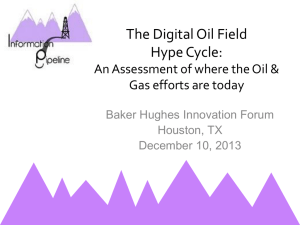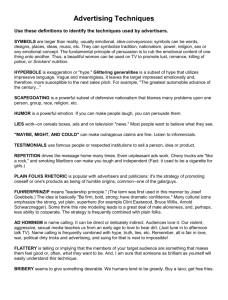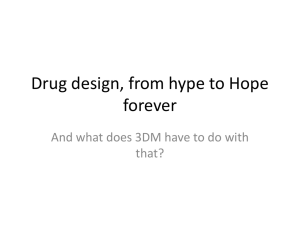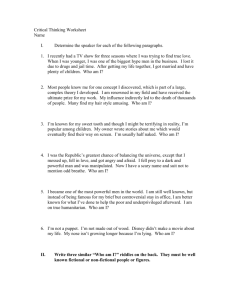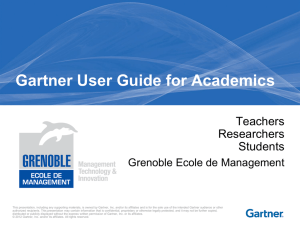Understanding Gartner's Hype Cycles
advertisement
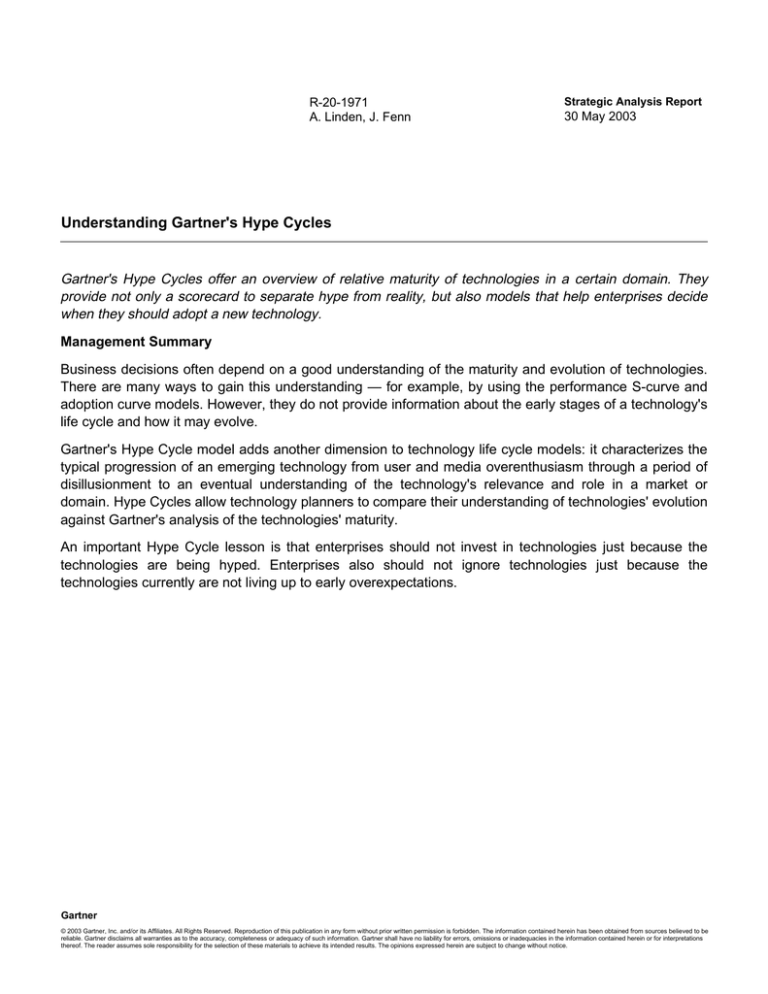
R-20-1971 A. Linden, J. Fenn Strategic Analysis Report 30 May 2003 Understanding Gartner's Hype Cycles Gartner's Hype Cycles offer an overview of relative maturity of technologies in a certain domain. They provide not only a scorecard to separate hype from reality, but also models that help enterprises decide when they should adopt a new technology. Management Summary Business decisions often depend on a good understanding of the maturity and evolution of technologies. There are many ways to gain this understanding — for example, by using the performance S-curve and adoption curve models. However, they do not provide information about the early stages of a technology's life cycle and how it may evolve. Gartner's Hype Cycle model adds another dimension to technology life cycle models: it characterizes the typical progression of an emerging technology from user and media overenthusiasm through a period of disillusionment to an eventual understanding of the technology's relevance and role in a market or domain. Hype Cycles allow technology planners to compare their understanding of technologies' evolution against Gartner's analysis of the technologies' maturity. An important Hype Cycle lesson is that enterprises should not invest in technologies just because the technologies are being hyped. Enterprises also should not ignore technologies just because the technologies currently are not living up to early overexpectations. Gartner © 2003 Gartner, Inc. and/or its Affiliates. All Rights Reserved. Reproduction of this publication in any form without prior written permission is forbidden. The information contained herein has been obtained from sources believed to be reliable. Gartner disclaims all warranties as to the accuracy, completeness or adequacy of such information. Gartner shall have no liability for errors, omissions or inadequacies in the information contained herein or for interpretations thereof. The reader assumes sole responsibility for the selection of these materials to achieve its intended results. The opinions expressed herein are subject to change without notice. Understanding Gartner's Hype Cycles © 2003 Gartner, Inc. and/or its Affiliates. All Rights Reserved. R-20-1971 30 May 2003 2 Understanding Gartner's Hype Cycles CONTENTS 1.0 What Is the Hype Cycle? ...........................................................................................................5 2.0 Phases of the Hype Cycle .........................................................................................................7 2.1 Technology Trigger ...................................................................................................................7 2.2 On the Rise.................................................................................................................................8 2.3 At the Peak of Inflated Expectations ........................................................................................8 2.4 Sliding Into the Trough of Disillusionment ..............................................................................8 2.5 Climbing the Slope of Enlightenment.......................................................................................8 2.6 Entering the Plateau of Productivity.........................................................................................9 2.7 Post-Plateau ...............................................................................................................................9 3.0 The Time-to-Maturity Assessment............................................................................................9 4.0 Positioning a Technology on the Hype Cycle ........................................................................10 5.0 Special Hype Cycle Circumstances........................................................................................10 6.0 Lessons of the Hype Cycle .....................................................................................................11 © 2003 Gartner, Inc. and/or its Affiliates. All Rights Reserved. R-20-1971 30 May 2003 3 Understanding Gartner's Hype Cycles FIGURES Figure 1. The Hype Curve ........................................................................................................................5 Figure 2. Technology Life Cycle Models.................................................................................................6 Figure 3. Phases of the Hype Cycle ........................................................................................................7 © 2003 Gartner, Inc. and/or its Affiliates. All Rights Reserved. R-20-1971 30 May 2003 4 Understanding Gartner's Hype Cycles 1.0 What Is the Hype Cycle? Gartner's Hype Cycle, introduced in 1995, characterizes the typical progression of an emerging technology from overenthusiasm through a period of disillusionment to an eventual understanding of the technology's relevance and role in a market or domain (see Figure 1). The first part of the hype curve is driven by vacuous hype — mainly by the media, which speculates on the technology's prospects. The second part of the hype curve primarily is driven by performance gains and adoption growth. Visibility Don’t Join in Just Because It’s “In” Positive Hype Negative Hype Don’t Miss Out Just Because It’s “Out” Technology Trigger Peak of Inflated Expectations Trough of Disillusionment Slope of Enlightenment Plateau of Productivity Maturity Source: Gartner Research (May 2003) Figure 1. The Hype Curve The Hype Cycle: • Establishes the expectation that most technologies will inevitably progress through the pattern of overenthusiasm and disillusionment • Provides a snapshot of the relative maturity of technologies within a certain segment of the IT world, such as a technology area, horizontal or vertical business market, or a certain demographic audience • Has a simple and clear message: Enterprises should not invest in a technology just because it is being hyped, nor should they ignore a technology just because it is not living up to early overexpectations © 2003 Gartner, Inc. and/or its Affiliates. All Rights Reserved. R-20-1971 30 May 2003 5 Understanding Gartner's Hype Cycles Several technology life cycle models attempt to gauge the evolution of a technology. The two most popular are the performance S-curve, which shows the increase in a technology's performance over time, and the adoption curve, which shows market adoption over time (see Figure 2). Performance S-Curve Gartner‘s Hype Cycle Adoption Curve Extended Hype Cycle Curve Time Source: Gartner Research (May 2003) Figure 2. Technology Life Cycle Models The Hype Cycle adds another dimension to these models. In addition to charting technology maturity, Hype Cycles also reflect human attitudes to technology. Most technologies conform to the Hype Cycle because the invariant in the equation is people, not the technology. (The observation that hype precedes maturity has been noted by Howard Fosdick and others.) The Hype Cycle curve typically occurs early in the technology's life cycle. The peak of hype occurs when there is almost no adoption in the marketplace and the performance of products (if there are any) is poor — unless enterprises have specialized deployments and customize products for their needs. Sometimes, the inflection point of a technology's performance, as well as its adoption, happens before or coincides with the hype peak (for example, instant messaging, Short Message Service and peer-to-peer content exchanges). These are the extreme "fast-runner" technologies that are difficult to detect in advance. The Hype Cycle shows two stages of upward direction (that is, increasing hype) — the lead up to the Peak of Inflated Expectations and the rise up the Slope of Enlightenment. The first rise in hype is the primarily unsubstantial hype that occurs when a technology is first discussed in the media. Some technologies experience multiple rounds of vacuous hype before beginning a more-serious growth path. The second stage of hype is associated with the beginning of real adoption growth. In many technology markets, another "mini-peak" of hype may occur that launches the technology up the Slope of Enlightenment. The Hype Cycle is also a measurement of knowledge and risk. At the beginning of the cycle, enterprises know nothing about a technology and cannot make informed judgements about its costs and benefits. Therefore, the risk is high. At the end of the cycle, enterprises know more about the technology; thus, they can make informed decisions about when and where to apply it. Therefore, the risk is much lower. Each technology's Hype Cycle is on a different scale based on its overall perceived importance to business and society. For example, mesh networks are an interesting method of leveraging peer-to-peer wireless networking bandwidth, but they will be relevant primarily to wireless network service providers. Other technologies that will appeal to a large number of enterprises (for example, Web services) or consumers (for example, video on demand) will attain much higher levels of exposure and hype. © 2003 Gartner, Inc. and/or its Affiliates. All Rights Reserved. R-20-1971 30 May 2003 6 Understanding Gartner's Hype Cycles Therefore, even when mesh networking is at the peak of its hype curve, it may still receive less overall "hype volume" than Web services or video on demand. The Hype Cycle ends at the beginning of the Plateau of Enlightenment. This is the point at which mainstream adoption of the technology surges, and the technology hits the steepest part of its adoption curve. This typically begins at approximately 30 percent adoption by the technology's target audience. 2.0 Phases of the Hype Cycle The Hype Cycle does not cover the entire technology life cycle (from inception to decline). It addresses the early stages, when hype and mismatched expectations are at their highest levels. These stages are caused by market events (see Figure 3). At the Peak First-generation products, high price, lots of customization needed On the Rise Sliding Into the Trough Negative press begins Climbing the Slope Consolidation and failures No working products Post-Plateau Plateau High-growth phase adoption starts: approximately 30 percent of the target audience has adopted or is adopting the technology Second/third rounds of venture capital funding Mass media hype begins Less than 5 percent adoption Startup companies, first round of venture capital funding Laboratory prototypes Third-generation products, out of the box R&D Technology Trigger Pilots: Second-generation products, some services A Deployment: C B B A C Source: Gartner Research (May 2003) Figure 3. Phases of the Hype Cycle 2.1 Technology Trigger The Technology Trigger is a technological breakthrough, public demonstration, press release or other event that generates significant publicity and industry interest in an emerging technology. Typically no usable products exist, only research and laboratory prototypes (for example, micro fuel cells in 2003). Venture capitalists may provide some early funding just after the Trigger, if they expect the technology to be a fast runner. © 2003 Gartner, Inc. and/or its Affiliates. All Rights Reserved. R-20-1971 30 May 2003 7 Understanding Gartner's Hype Cycles 2.2 On the Rise On the rise to the Peak of Inflated Expectations, media articles explain the technology and discuss its potential impact on business and society. First-generation products emerge, but they usually are highly specialized products or extremely difficult to use. Products are high margin because vendors are still trying to recover R&D costs, and the technology is expensive compared to its cost of production. For example, in 2002, Bluetooth products such as headsets cost $200, while the final silicon cost of Bluetooth chips likely will be approximately $5. This is a good stage for venture capitalists to enter the market, before evaluations are at their apex. During this phase, some particularly aggressive enterprises may start to pilot the technology, particularly if it contributes to critical business issues. These enterprises work closely with the vendors to create customized solutions for their requirements. 2.3 At the Peak of Inflated Expectations As the Peak crests, the number of vendors offering the technology increases. These vendors are primarily startup companies and small vendors that try to use the increasing amount of hype for their marketing benefit. A growing number of enterprises start to examine how the technology may fit within their business strategies, although most do not take action at this stage. Venture capitalists may be interested in selling some of the startups that they equipped with early funding. As problems with first-generation products become visible, often because the technology is pushed to its limits, negative publicity starts to push the technology into the Trough of Disillusionment (for example, Web services in 2002 and biometrics in 2003). 2.4 Sliding Into the Trough of Disillusionment Because the technology does not live up to enterprises' and the media's overinflated expectations, it is rapidly discredited. Some of the early trials end in highly publicized failures. Media interest wanes, except for a few cautionary tales. A significant amount of vendor consolidation and failure occurs. Later-stage investors may be interested in funding vendors during this phase because equity is fairly inexpensive after the "microbubble" at the Peak of Inflated Expectations has burst. However, amid the disillusionment, trials are ongoing and vendors are improving products based on early feedback regarding problems and issues. Some early adopters find some benefit in adopting the technology. For some slow-moving technologies (for example, biometrics), workable and cost-effective solutions emerge and provide value in niche domains, even while the technology remains in the Trough. The Trough of Disillusionment coincides with the "chasm" in Geoffrey Moore's classic book, "Crossing the Chasm." During this stage, vendors need to launch their products from a few early adopters to adoption by a majority of enterprises to begin the climb up the Slope of Enlightenment. 2.5 Climbing the Slope of Enlightenment Focused experimentation and real-world experience by an increasingly diverse range of enterprises lead to a better understanding of the technology's applicability, risks and benefits. Vendors seek mezzanine or later-round funding for marketing and sales support to pull themselves up the Slope. Second-and thirdgeneration products are launched, and methodologies and tools are added to ease the development process. The service component declines as a percentage of the sale. Technologically aggressive ("Type A") enterprises are relatively comfortable adopting the technology, and moderately aggressive ("Type B") enterprises start to investigate and pilot the technology. Conservative ("Type C") enterprises remain wary. © 2003 Gartner, Inc. and/or its Affiliates. All Rights Reserved. R-20-1971 30 May 2003 8 Understanding Gartner's Hype Cycles At the beginning of the Slope, the penetration often is significantly less than 5 percent of the potential market segment. This will grow to approximately 30 percent as the technology enters the Plateau of Enlightenment. 2.6 Entering the Plateau of Productivity The Plateau represents the beginning of mainstream adoption, when the real-world benefits of the technology are demonstrated and accepted. Technologies become increasingly embedded into solutions that increasingly are "out of the box," with decreasing service elements as the technology matures. The majority of Type B, then Type C, enterprises adopt the technology. As a high-profile technology matures, an "ecosystem" often evolves around it. The ecosystem supports multiple providers of products and services, and also a market for related products and services that extend or are based on the technology (for example, virtual private networks in 2003). The final height of the Plateau varies according to whether the technology is broadly applicable or benefits only a niche market. 2.7 Post-Plateau As a technology achieves full maturity and supports thousands of enterprises and millions of users, its hype typically disappears. Only a few specialist magazines continue coverage of new aspects of implementing and maintaining the technology. Often there may be innovations around this technology that will follow their own Hype Cycles. 3.0 The Time-to-Maturity Assessment Technologies do not move at a uniform speed through the Hype Cycle. It often takes years for a technology to traverse the Hype Cycle — some technologies may take decades. There are three adoption speeds: • "Fast-track" technologies go through the Hype Cycle within two to four years. This occurs when the performance curve inflects early in the life cycle of a technology. These technologies find themselves adopted without much fanfare, bypassing the Peak of Inflated Expectations and Trough of Disillusionment. Many enterprises are unaware of their sudden maturity and applicability, such as what has happened with instant messaging and Short Message Service. Fast-track technology indicators include: • − High value − Simplicity of use by enterprises and users − Several strong vendors that support the technology − Use of the current infrastructure − A rapid transition from consumer to corporate use "Long-fuse" technologies may take one or two decades to traverse the Hype Cycle, such as e-mail, the Internet and the emerging nanotechnology. For example, object orientation took 10 to 15 years to migrate from academia and other research organizations to become a mainstream development technique; the delay was partly due to skills and development process barriers. Many long-fuse © 2003 Gartner, Inc. and/or its Affiliates. All Rights Reserved. R-20-1971 30 May 2003 9 Understanding Gartner's Hype Cycles technologies seem to be perpetually emerging (for example, biometrics, artificial intelligence and video on demand) and cycling between the Peak and Trough in public attention. Long-fuse technology indicators include: • 4.0 − A science-fiction-style fascination with the technology that is far ahead of its real capabilities (for example, artificial intelligence, nanocomputing and speech recognition) − Inherent complexity that requires advances in basic science and engineering (for example, quantum computing and heads-up displays) − Adoption/regulation issues (for example, videoconferencing, biometrics and trusted computing) − Reliance on a new infrastructure (ecosystem) that needs time to evolve (for example, public-key infrastructure and digital signatures require regulation and standardized business applications, "smart cards" need readers, and fuel cells require a distribution network) − Dependence on professional skills that are unavailable or in short supply (for example, standalone data mining, text mining, knowledge management, standardization and data integration) − Major changes to business processes or the creation of a new business model (for example, trusted computing, nanocomputing and public-key infrastructure) "Normal" technologies with relatively few inhibitors usually traverse the Hype Cycle in five to eight years. Positioning a Technology on the Hype Cycle Gartner analysts position technologies on the Hype Cycle based on a consensus assessment of hype and maturity. During the first part of the Hype Cycle, when there are many uncertainties regarding a technology, its position on the hype curve is guided more by its hype levels than its perceived maturity. At the later stages, as more information about maturity, performance and adoption become available, the hype plays a lesser role in determining the technology's position on the Hype Cycle. A technology may have radically different positions on different Hype Cycles. An enterprise's ability to deploy a technology may exceed its ability to manage that technology well, resulting in different positions for the technology on, for example, the Hype Cycle for Application Development and the Hype Cycle for Enterprise Systems Management. In addition, different applications of a technology may lead to different positions — for example, speech recognition in the call center may be further evolved (on the Slope of Enlightenment) than speech recognition on the desktop (in the Trough of Disillusionment). Application considerations may lead to different positions of the same technology on different horizontal (for example, customer relationship management) or vertical (for example, government) Hype Cycles. 5.0 Special Hype Cycle Circumstances Technologies can experience special or unusual circumstances as they move through the Hype Cycle (see "Escaping the Hype Cycle: Dead or Alive?" TG-15-2648). • Technologies can become embedded — that is, they cease to exist as a technology category or concept; instead, the functionality is embedded in other products (for example, push technology). • Technologies can be split into several subconcepts (for example, grid computing splits into commercial grids and scientific grids), as users differentiate between different application contexts and contextual requirements. Similarly, technologies from different disciplines can merge and then re- © 2003 Gartner, Inc. and/or its Affiliates. All Rights Reserved. R-20-1971 30 May 2003 10 Understanding Gartner's Hype Cycles emerge. For example, in the 1990s, machine learning from artificial intelligence and regression models from statistics merged to become data mining. • "Phoenix" technologies continually cycle through enthusiasm and disillusionment (for example, intelligent agents, artificial intelligence, collaboration and biometrics). Events often can trigger new attention on a technology, such as terrorist attacks or disease outbreaks. Even some prominent media articles, or the complete lack thereof, can make some technologies cycle through repeatedly. These technologies usually are extremely slow-moving technologies with principal methodological challenges. There often is a "double dip" phenomenon, whereby the media re-hypes a technology at the beginning of the Slope of Enlightenment, just before the technology hits a larger base of enterprise or user interest. • "Ghost" technologies (for example, Internet terminals, interactive TV, video on demand and powerline networking) are placed "on hold" because they have failed to deliver on their promises. These technologies basically work, but they do not have enough user interest or business justification to drive adoption. They usually are in the Trough of Disillusionment for a long time before they become obsolete or re-emerge, often as embedded functionality in other technologies. • Technologies can become obsolete or "extinct" prior to reaching the Plateau of Productivity. This premature obsolescence typically results from the emergence of a competing technology. For example, VoxML was overtaken by VoiceML; analog high-definition TV has ceded to digital highdefinition TV. • As part of the normal evolution of technology, the target audience for the technology may change from what was originally intended. The technology's applicability may grow to encompass new classes of users or shrink to become successful only in niche applications. Technologies that have been reduced to niche applications include the artificial intelligence technologies that were hyped during the 1980s, such as expert systems, virtual reality, genetic algorithms and fuzzy logic. Their original hype indicated that they should have had more impact on the world. However, these technologies may re-emerge from their current niche applications. 6.0 Lessons of the Hype Cycle Despite its simplicity, the message of the Hype Cycle sometimes becomes confused when it is presented out of context. The major lessons of the Hype Cycle are: • Technologies should not be adopted just because they are at the Peak of Inflated Expectations, nor should they necessarily be abandoned at the Trough of Disillusionment. • Even Type A enterprises should be selectively aggressive regarding which technologies they adopt early. Only technologies that are of strategic importance should be adopted pre-Trough. • Type B and Type C enterprises may consider adopting technologies early if the technologies contribute to key business objectives. • The Hype Cycle is a useful educational tool for helping enterprises understand the inevitable pattern of excitement and disillusionment about technologies. However, for internal technology prioritization within the technology planning function, other approaches that explicitly rate opportunities in relation to each other are more effective — for example, technology radar screens (see "2002 Technology Radar Screen: Key Issues in Emerging IT," K-18-1918) or technology scorecards (see "Emerging Technologies: From Tracking to Evaluation," K-18-1819). © 2003 Gartner, Inc. and/or its Affiliates. All Rights Reserved. R-20-1971 30 May 2003 11 Understanding Gartner's Hype Cycles The Hype Cycle is most useful in explaining why the recommendations from technology planning groups may be different than what enterprises are hearing or reading in the media. At the Peak of Inflated Expectations, technology planners will caution, "Don't get caught up in the hype. Let's adopt it only if it is strategically important to us. Otherwise, let's wait for others to learn the hard lessons." In the Trough of Disillusionment, technology planners will recommend, "Let's start looking at the technology now because there are some solid products emerging and real-world experience about how to use the technology." © 2003 Gartner, Inc. and/or its Affiliates. All Rights Reserved. R-20-1971 30 May 2003 12
